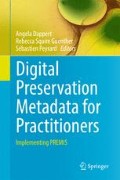Abstract
Digital preservation metadata profiles vary because of different content types held in the repository, different functions performed on them, different organizational mandates and processes, different policies, different technical platforms, and other reasons. Because of this, one important step in their development is the definition of a logical data model. The logical data model declares the key context-specific entities for which metadata needs to be created, the relationships between them, and the specific metadata properties that should be captured for them. This chapter describes the principles of how to create a logical data model. Chapters 5 through 12 go on to present a number of case studies that illustrate how specific data model issues have been decided for different entity types, for different content types, such as web archives, audiovisual or e-book materials, and for different organization types.
Access this chapter
Tax calculation will be finalised at checkout
Purchases are for personal use only
Preview
Unable to display preview. Download preview PDF.
References
PREMIS Editorial Committee (2015) PREMIS data dictionary for preservation metadata, version 3.0. http://www.loc.gov/standards/premis/v3/premis-3-0-final.pdf. Accessed 22 Feb 2016
Dappert A, Enders M (2008) Using METS, PREMIS and MODS for archiving eJournals. D-Lib Magazine, 14(9/10), ISSN 1082-9873. http://www.dlib.org/dlib/september08/dappert/09dappert.html. Accessed 22 Feb 2016
Author information
Authors and Affiliations
Corresponding author
Editor information
Editors and Affiliations
Rights and permissions
Copyright information
© 2016 Springer International Publishing Switzerland
About this chapter
Cite this chapter
Dappert, A. (2016). How to Develop a Digital Preservation Metadata Profile: Data Modeling. In: Dappert, A., Guenther, R., Peyrard, S. (eds) Digital Preservation Metadata for Practitioners. Springer, Cham. https://doi.org/10.1007/978-3-319-43763-7_4
Download citation
DOI: https://doi.org/10.1007/978-3-319-43763-7_4
Published:
Publisher Name: Springer, Cham
Print ISBN: 978-3-319-43761-3
Online ISBN: 978-3-319-43763-7
eBook Packages: Computer ScienceComputer Science (R0)

